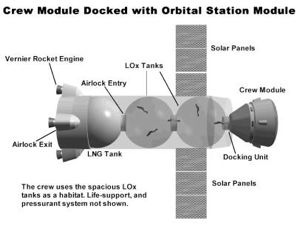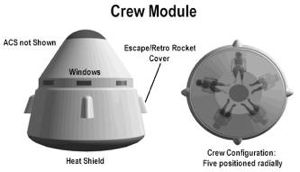
Home - Search - Browse - Alphabetic Index: 0- 1- 2- 3- 4- 5- 6- 7- 8- 9
A- B- C- D- E- F- G- H- I- J- K- L- M- N- O- P- Q- R- S- T- U- V- W- X- Y- Z
Neptune
 Neptune Credit: IOS |
Status: Design 2005. Payload: 4,500 kg (9,900 lb). Apogee: 400 km (240 mi).
The Neptune used the same stage-and-a-half design of the Sea Star technology demonstrator, with a large engine in a booster module and four smaller vernier engines attached to the main vehicle structure. The engines were larger versions of the LOX/LNG engines developed for Sea Star, generating a total of 2500 kN of thrust at liftoff.
A unique aspect of the Neptune was that the main rocket structure, once in orbit, could act as a small space station. A conical crew module attached to the top of the rocket, carrying up to five people, would undock, turn 180 degrees, and dock nose-first with the orbital station module. The module's two LOX tanks, each spheres six meters in diameter, would be purged of any remaining propellant and then pressurized to serve as habitation modules. IOS planned to use the Neptune to serve the orbital space tourism market, selling week-long trips for $2 million per person starting in 2008.
LEO Payload: 4,500 kg (9,900 lb) to a 400 km orbit at 52.00 degrees.
| Sea Star American sea-launched orbital launch vehicle. Sea-launched microsatellite orbital launch vehicle for payloads up to 13 kilograms and a test bed for the planned larger Neptune orbital launch vehicle. |
Family: orbital launch vehicle, Sea-Launched. Country: USA. Spacecraft: Neptune (Space Station). Agency: Interorbital Systems.
 | Neptune Credit: IOS |
 | Neptune Credit: IOS |
Back to top of page
Home - Search - Browse - Alphabetic Index: 0- 1- 2- 3- 4- 5- 6- 7- 8- 9
A- B- C- D- E- F- G- H- I- J- K- L- M- N- O- P- Q- R- S- T- U- V- W- X- Y- Z
© 1997-2019 Mark Wade - Contact
© / Conditions for Use